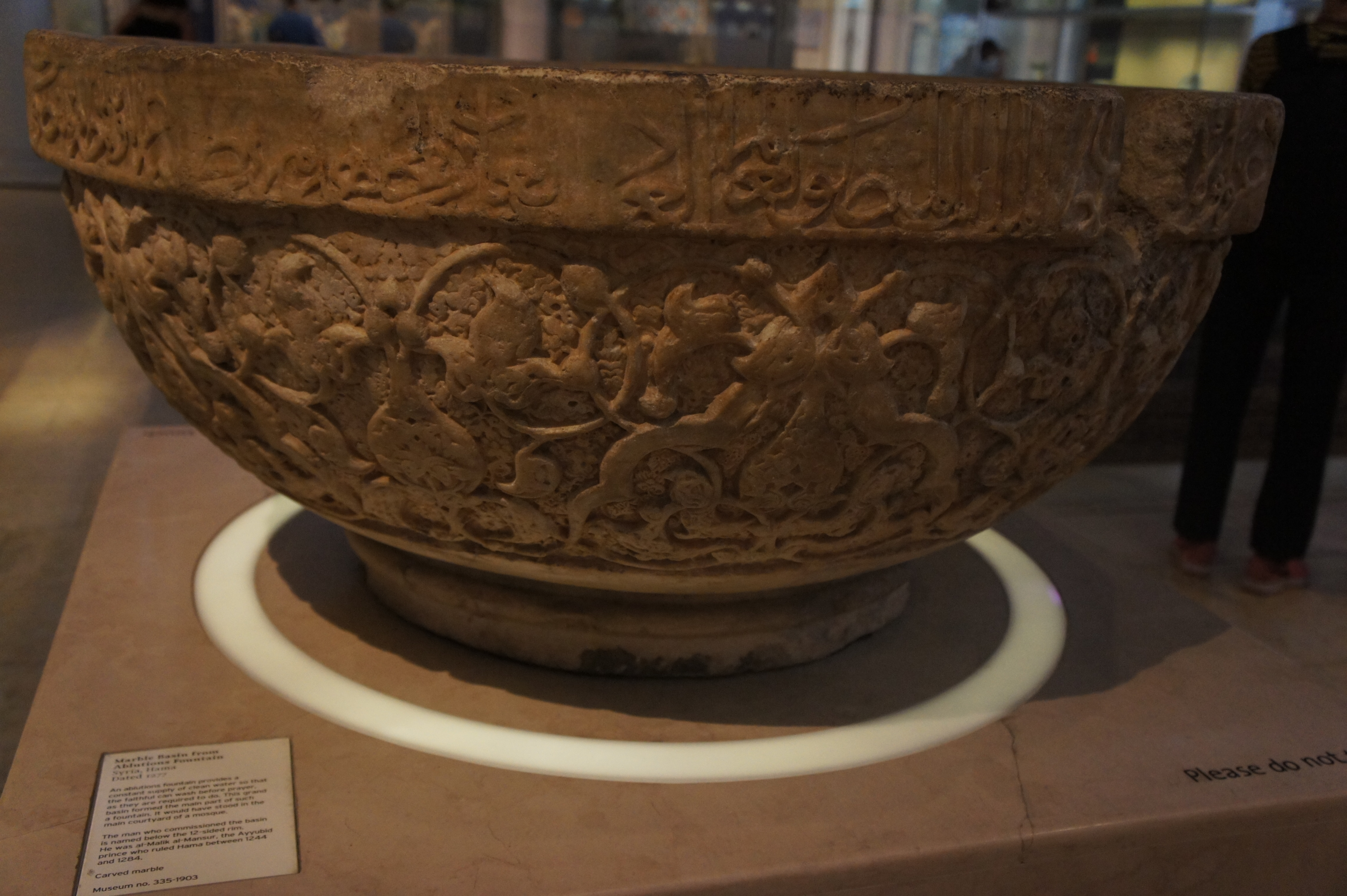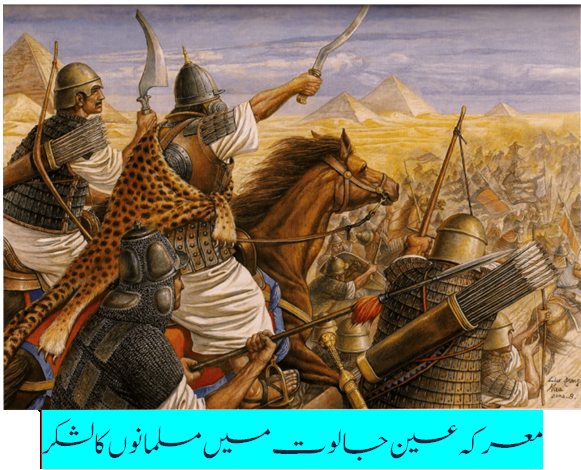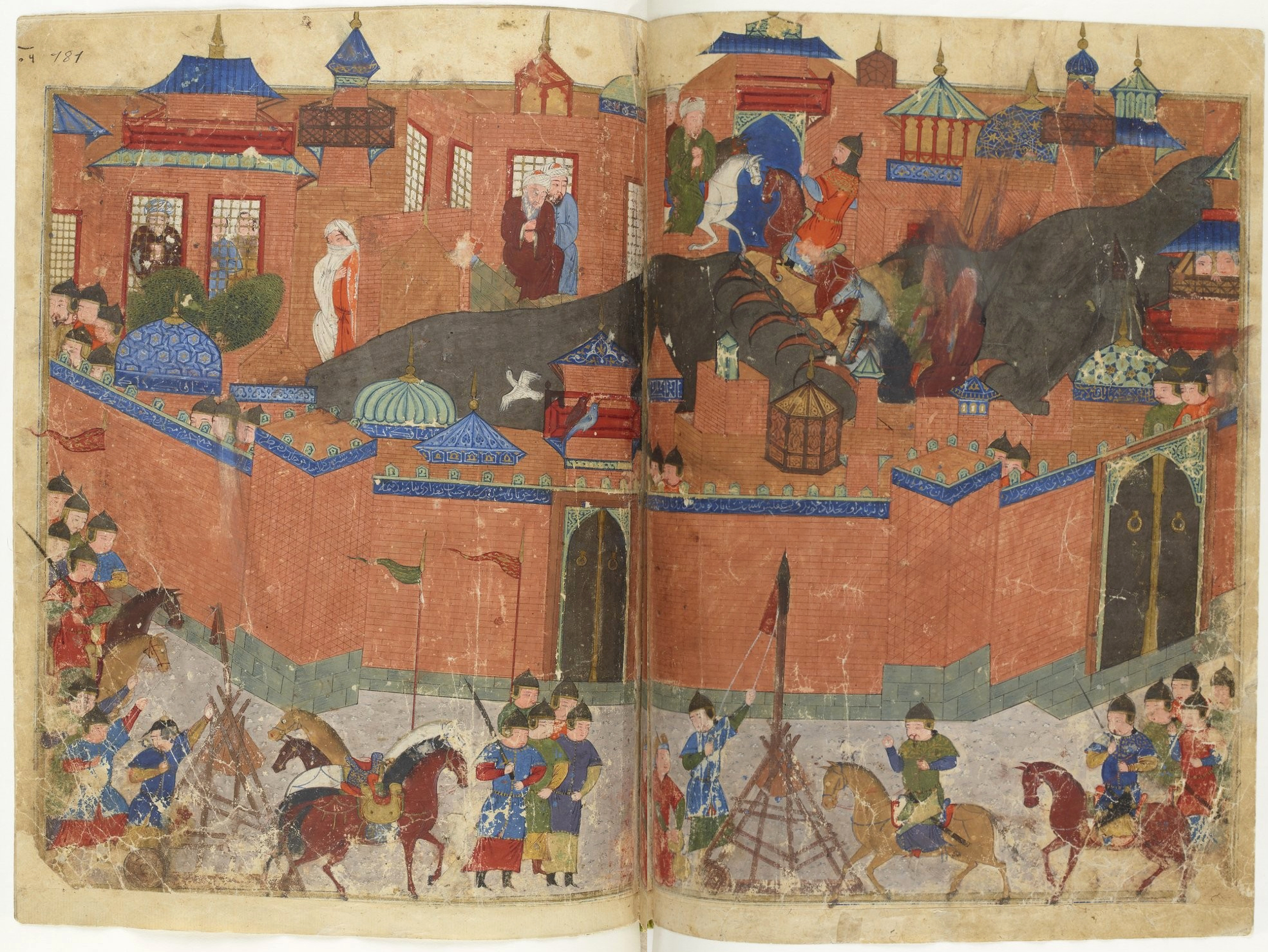|
Al-Malik Al-Mansour
Al-Mansur II Muhammad was the Ayyubid emir of Hama 1244–1284, son of al-Muzaffar II Mahmud and grandson of al-Mansur I Muhammad. He was the great-great grandson of Saladin’s brother Nur ad-Din Shahanshah. His mother was Ghaziya Khatun. Early years Al Mansur came to the throne at a time when the Egyptian Sultan As-Salih Ayyub was consolidating his power. In spring 1247 As-Salih Ayyub set out for Syria where he met emir Al-Ashraf Musa of Homs as well as Al Mansur. Both were young - Al-Ashraf Musa was eighteen and Al Mansur was just twelve - and new on their thrones. As-Salih Ayyub campaigned against his rival An-Nasir Yusuf of Aleppo but returned to Egypt to confront a new Crusader threat in 1249. Shortly afterwards he died. His son and successor Al-Muazzam Turanshah did not long outlive him and in 1250 the Ayyubid dynasty was overthrown in Egypt by the Bahri mamluks. Threats from Mamluks and Mongols The effect of this coup in Egypt was to make An-Nasir Yusuf of Aleppo ... [...More Info...] [...Related Items...] OR: [Wikipedia] [Google] [Baidu] |
Hama
, timezone = EET , utc_offset = +2 , timezone_DST = EEST , utc_offset_DST = +3 , postal_code_type = , postal_code = , area_code = Country code: 963 City code: 33 , geocode = C2987 , blank_name = Climate , blank_info = BSk , website = , footnotes = , name = Hama ( ar, حَمَاة ', ; syr, ܚܡܬ, ħ(ə)mɑθ, lit=fortress; Biblical Hebrew: ''Ḥamāṯ'') is a city on the banks of the Orontes River in west-central Syria. It is located north of Damascus and north of Homs. It is the provincial capital of the Hama Governorate. With a population of 854,000 (2009 census), Hama is the fourth-largest city in Syria after Damascus, Aleppo and Homs. The city is renowned for its sev ... [...More Info...] [...Related Items...] OR: [Wikipedia] [Google] [Baidu] |
Al-Muazzam Turanshah
Turanshah, also Turan Shah ( ar, توران شاه), (? – 2 May 1250), (''epithet:'' al-Malik al-Muazzam Ghayath al-Din Turanshah ( ar, الملك المعظم غياث الدين توران شاه)) was a Kurdish ruler of Egypt, a son of Sultan As-Salih Ayyub. A member of the Ayyubid Dynasty, he became Sultan of Egypt for a brief period in 1249–50. Background Turanshah was not trusted by his father, who sent him to Hasankeyf to keep him away from Egyptian politics. He learned of his father's death from Faris ad-Din Aktai, commander of his father's Bahri Mamluks, who had been sent from Egypt to bring him back and pursue the war against Louis IX of France and the Seventh Crusade. Aktai arrived at Hasankeyf early in Ramadan 647/December 1249 and a few days later, 11 Ramadan/18 December, Turanshah and around fifty companions had started off for Egypt. The party took a circuitous route to avoid being intercepted by hostile Ayyubid rivals and on 28 Ramadan 647/4 Januar ... [...More Info...] [...Related Items...] OR: [Wikipedia] [Google] [Baidu] |
Medieval Child Rulers
In the history of Europe, the Middle Ages or medieval period lasted approximately from the late 5th to the late 15th centuries, similar to the post-classical period of global history. It began with the fall of the Western Roman Empire and transitioned into the Renaissance and the Age of Discovery. The Middle Ages is the middle period of the three traditional divisions of Western history: classical antiquity, the medieval period, and the modern period. The medieval period is itself subdivided into the Early, High, and Late Middle Ages. Population decline, counterurbanisation, the collapse of centralized authority, invasions, and mass migrations of tribes, which had begun in late antiquity, continued into the Early Middle Ages. The large-scale movements of the Migration Period, including various Germanic peoples, formed new kingdoms in what remained of the Western Roman Empire. In the 7th century, North Africa and the Middle East—most recently part of the Eastern Roma ... [...More Info...] [...Related Items...] OR: [Wikipedia] [Google] [Baidu] |
Sunni Muslims
Sunni Islam () is the largest branch of Islam, followed by 85–90% of the world's Muslims. Its name comes from the word '' Sunnah'', referring to the tradition of Muhammad. The differences between Sunni and Shia Muslims arose from a disagreement over the succession to Muhammad and subsequently acquired broader political significance, as well as theological and juridical dimensions. According to Sunni traditions, Muhammad left no successor and the participants of the Saqifah event appointed Abu Bakr as the next-in-line (the first caliph). This contrasts with the Shia view, which holds that Muhammad appointed his son-in-law and cousin Ali ibn Abi Talib as his successor. The adherents of Sunni Islam are referred to in Arabic as ("the people of the Sunnah and the community") or for short. In English, its doctrines and practices are sometimes called ''Sunnism'', while adherents are known as Sunni Muslims, Sunnis, Sunnites and Ahlus Sunnah. Sunni Islam is sometimes referre ... [...More Info...] [...Related Items...] OR: [Wikipedia] [Google] [Baidu] |
Ayyubid Emirs Of Hama
The Ayyubid dynasty ( ar, الأيوبيون '; ) was the founding dynasty of the medieval Sultanate of Egypt established by Saladin in 1171, following his abolition of the Fatimid Caliphate of Egypt. A Sunni Muslim of Kurdish origin, Saladin had originally served Nur ad-Din of Syria, leading Nur ad-Din's army in battle against the Crusaders in Fatimid Egypt, where he was made Vizier. Following Nur ad-Din's death, Saladin was proclaimed as the first Sultan of Egypt, and rapidly expanded the new sultanate beyond the frontiers of Egypt to encompass most of the Levant (including the former territories of Nur ad-Din), in addition to Hijaz, Yemen, northern Nubia, Tarabulus, Cyrenaica, southern Anatolia, and northern Iraq, the homeland of his Kurdish family. By virtue of his sultanate including Hijaz, the location of the Islamic holy cities of Mecca and Medina, he was the first ruler to be hailed as the Custodian of the Two Holy Mosques, a title that would be held by all subsequent ... [...More Info...] [...Related Items...] OR: [Wikipedia] [Google] [Baidu] |
13th-century Ayyubid Rulers
The 13th century was the century which lasted from January 1, 1201 ( MCCI) through December 31, 1300 ( MCCC) in accordance with the Julian calendar. The Mongol Empire was founded by Genghis Khan, which stretched from Eastern Asia to Eastern Europe. The conquests of Hulagu Khan and other Mongol invasions changed the course of the Muslim world, most notably the Siege of Baghdad (1258), the destruction of the House of Wisdom and the weakening of the Mamluks and Rums which, according to historians, caused the decline of the Islamic Golden Age. Other Muslim powers such as the Mali Empire and Delhi Sultanate conquered large parts of West Africa and the Indian subcontinent, while Buddhism witnessed a decline through the conquest led by Bakhtiyar Khilji. The Southern Song dynasty would begin the century as a prosperous kingdom but would eventually be invaded and annexed into the Yuan dynasty of the Mongols. The Kamakura Shogunate of Japan would be invaded by the Mongols. Goryeo ... [...More Info...] [...Related Items...] OR: [Wikipedia] [Google] [Baidu] |
1284 Deaths
1 (one, unit, unity) is a number representing a single or the only entity. 1 is also a numerical digit and represents a single unit of counting or measurement. For example, a line segment of ''unit length'' is a line segment of length 1. In conventions of sign where zero is considered neither positive nor negative, 1 is the first and smallest positive integer. It is also sometimes considered the first of the infinite sequence of natural numbers, followed by 2, although by other definitions 1 is the second natural number, following 0. The fundamental mathematical property of 1 is to be a multiplicative identity, meaning that any number multiplied by 1 equals the same number. Most if not all properties of 1 can be deduced from this. In advanced mathematics, a multiplicative identity is often denoted 1, even if it is not a number. 1 is by convention not considered a prime number; this was not universally accepted until the mid-20th century. Additionally, 1 is the s ... [...More Info...] [...Related Items...] OR: [Wikipedia] [Google] [Baidu] |
Aybak
Izz al-Din AybakThe name Aybeg or Aibak or Aybak is a combination of two Turkic words, "Ay" = Moon and "Beg" or variant "Bak" = Emir in Arabic. -(Al-Maqrizi, Note p.463/vol.1 ) ( ar, عز الدين أيبك) (''epithet:'' al-Malik al-Mu'izz Izz al-Din Aybak al-Jawshangir al-Turkmani al-Salihi, ar, links=no, الملك المعز عز الدين أيبك التركماني الجاشنكير الصالحى) was the first of the Mamluk sultans of Egypt in the Turkic Bahri line.Though Aybak is regarded by historian as a Mamluk, he actually served in the court of as-Salih Ayyub as an Emir/military commander and not as a Mamluk.- Shayal, p. 153/ vol.2- Al-Maqrizi, p. 463/vol.1 – According to Ibn Taghri as-Salih Ayyub bought him before he became a Sultan and he promoted him to the position an Emir. The rank which Aybak used was of a Khawanja (خوانجا Sultan's accountant ). Ibn Taghri, PP.103-273/ The Sultanate of al-Muizz Aybak al-Turkumani.Some historians, however, conside ... [...More Info...] [...Related Items...] OR: [Wikipedia] [Google] [Baidu] |
Faris Ad-Din Aktai
Faris al-Din Aktay al-Jamdar ( ar, فارس الدين أقطاى الجمدار) (d. 1254, Cairo) was a Turkic- Kipchak Emir (prince) and the leader of the Mamluks of the Bahri dynasty. Biography When the Ayyobid Sultan as-Salih Ayyub died Aktay was sent to Hasankeyf to recall Turanshah, the son and heir of the dead sultan, to Egypt. During the Battle of al-Mansurah he was one of the Mamluk commanders who defeated the Frankish forces led by the French king Louis IX. Aktay was one of the Mamluks who collaborated in the murdering of Turanshah after the battle of al-Mansurah. During the era of Sultan Aybak, he led the Egyptian forces that defeated the army of the Ayyubid ruler of Syria an-Nasir Yusuf at Gaza in October 1250 and, as a general, he played a crucial role in the final defeat of an-Nasir Yusuf in the . In 1251 he conquered parts of Syria and in 1252 the port city of Alexandria in northern Egypt became his own domain. He was known for his devotion to Islam and harsh ... [...More Info...] [...Related Items...] OR: [Wikipedia] [Google] [Baidu] |
Battle Of Ain Jalut
The Battle of Ain Jalut (), also spelled Ayn Jalut, was fought between the Bahri Mamluks of Egypt and the Mongol Empire on 3 September 1260 (25 Ramadan 658 AH) in southeastern Galilee in the Jezreel Valley near what is known today as the Spring of Harod (). The battle marked the height of the extent of Mongol conquests, and was the first time a Mongol advance was permanently beaten back in direct combat on the battlefield. Continuing the westward expansion of the Mongol Empire, the armies of Hulagu Khan captured and sacked Baghdad in 1258, along with the Ayyubid capital of Damascus sometime later. Hulagu sent envoys to Cairo demanding Qutuz surrender Egypt, to which Qutuz responded by killing the envoys and displaying their heads on the Bab Zuweila gate of Cairo. Shortly after this, Möngke Khan was slain in battle against the Southern Song. Hulagu returned to Mongolia with the bulk of his army to attend the kurultai in accordance with Mongol customs, leaving approxim ... [...More Info...] [...Related Items...] OR: [Wikipedia] [Google] [Baidu] |
Qutuz
Saif ad-Din Qutuz ( ar, سيف الدين قطز; died 24 October 1260), also romanization of Arabic, romanized as Kutuz or Kotuz and fully al-Malik al-Muẓaffar Sayf ad-Dīn Quṭuz (), was a military leader and the third or fourth of the Mamluk Sultans of Egypt in the Turkic peoples, Turkic line. He reigned as Sultan for less than a year, from 1259 until his assassination in 1260, but served as the de facto ruler for two decades. Sold into slavery in Egypt, he rose to become vice-Sultan for over 20 years, becoming the power behind the throne. He was prominent in defeating the Seventh Crusade, which invaded Egypt in 1249–50. When Egypt was threatened by the Mongols in 1259, he took control of the military and deposed the reigning Sultan, 15-year-old Sultan Al-Mansur Ali. The centers of Islamic power in Syria and Baghdad were conquered by the Mongols, and the center of the Islamic Empire moved to Egypt, which became their next target. Qutuz led an Egyptian Mamluk army n ... [...More Info...] [...Related Items...] OR: [Wikipedia] [Google] [Baidu] |
Hulagu Khan
Hulagu Khan, also known as Hülegü or Hulegu ( mn, Хүлэгү/ , lit=Surplus, translit=Hu’legu’/Qülegü; chg, ; Arabic: fa, هولاکو خان, ''Holâku Khân;'' ; 8 February 1265), was a Mongol ruler who conquered much of Western Asia. Son of Tolui and the Keraite princess Sorghaghtani Beki, he was a grandson of Genghis Khan and brother of Ariq Böke, Möngke Khan, and Kublai Khan. Hulagu's army greatly expanded the southwestern portion of the Mongol Empire, founding the Ilkhanate of Persia, a precursor to the eventual Safavid dynasty, and then the modern state of Iran. Under Hulagu's leadership, the siege of Baghdad (1258) destroyed Baghdad's standing in the Islamic Golden Age and weakened Damascus, causing a shift of Islamic influence to the Mamluk Sultanate in Cairo and ended the Abbasid Dynasty. Background Hulagu was born to Tolui, one of Genghis Khan's sons, and Sorghaghtani Beki, an influential Keraite princess and a niece of Toghrul in 1217. Noth ... [...More Info...] [...Related Items...] OR: [Wikipedia] [Google] [Baidu] |










.jpeg/1200px-Prise_d'Alamût_(1256).jpeg)